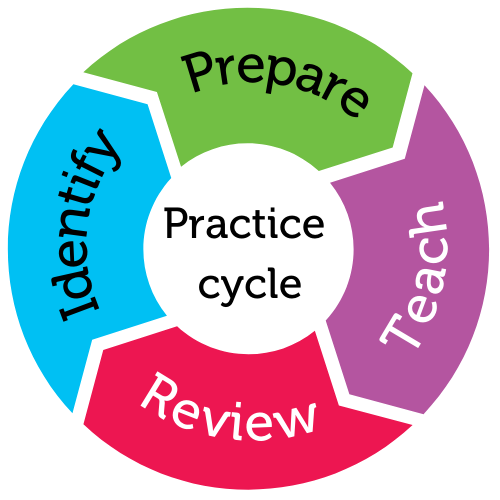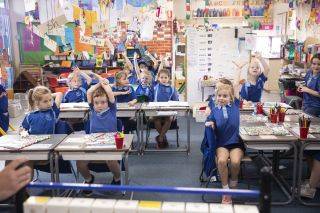
For student year
Helps students to
- build self-esteem
- stay on task
Helps teachers to
- increase teaching moments
- strengthen relationships
Summary
For the secondary school version of this practice, go to:
Respond constructively to student behaviour (Years 7 to 12)
How teachers respond to behaviour can contribute to a positive, more inclusive learning environment and help prevent inappropriate behaviour. Clear expectations and constructive responses to behaviour can assist students who have difficulty staying on task, completing work, or regulating themselves in class. Responding in this way also builds rapport and trust between student and teacher, which makes managing behaviour easier.
Constructive responses to behaviour, include:
• using specific praise that’s individualised to reflect what the student has achieved or is undertaking
• positive reinforcement of appropriate behaviours as opposed to a punitive response
• looking holistically at a student’s behaviour to understand what might be causing it
Many students, but especially those new to school or on the autism spectrum, benefit from consistent routines that help them know what behaviour is and isn’t acceptable in the classroom or during a specific activity.
“You can effectively manage your classroom by reinforcing positive behaviour and delivering constructive responses to inappropriate behaviour.”
How the practice works
Watch this video to learn more about this practice.
Duration 2:44
Australian Professional Standards for Teachers related to this practice
4.1 - support student participation
4.3 - manage challenging behaviour
For further information, see Australian Professional Standards for Teachers AITSL page
Preparing to teach
1. Identify behaviours you want to encourage or reduce
- Think about and plan how you will respond to these behaviours. Having a list of planned responses that suit your teaching style means you are more likely to use them authentically and efficiently.
2. Choose strategies to reinforce appropriate behaviour
Strategies might include:
- specific praise – providing positive verbal feedback specific to the student and the behaviour, e.g. 'Thank you for raising your hand to ask a question, Ash'.
- clearly stating your expectations at the beginning of each lesson or activity.
3. Choose strategies to respond to inappropriate behaviour
Strategies might include:
- restating positive expectations – reminding students of the behaviour you want to see in the classroom
- differential reinforcement – reinforcing or praising only appropriate behaviours and removing or stopping reinforcements for other behaviours
- conferencing – one-on-one problem-solving with a student when they are calm, asking students to suggest strategies for the future.
NB: As you choose strategies, always refer to the student behaviour policy and guidelines within the relevant state or school system.
It works better if:
- you reinforce appropriate behaviour consistently
- you offer praise for students’ efforts or for their use of specific work strategies rather than for intelligence or for the mastery of a skill, helping students to build a growth mindset
- students are collaborated with to create a list of reinforcing items or activities. Providing choices will increase students’ motivation.
When responding to inappropriate behaviour:
- use positive, constructive, and consistent responses
- give specific praise for positive behaviours (see the practice brief)
- give students a manageable task, once the student is calm, that focuses on their strengths or interests, i.e. a task they will succeed in.
It doesn't work if:
- reinforcement or response does not occur as soon as possible following the target behaviour. If reinforcement or response is delayed, the student may not understand which behaviour is being rewarded or is inappropriate.
In the classroom
1. Explicitly state expectations
At the start of each lesson, explicitly state expectations for behaviour in the lesson.
2. Observe
Before responding to a particular behaviour, consider why it has happened. What is going on with the student? The student may have experienced:
- confusion (even if you told them what to do)
- a sensory trigger
- miscommunication with a peer
- difficulty communicating
- a feeling of being overwhelmed
- a lack of belonging, respect, or self-efficacy.
3. Respond immediately
Respond positively and specifically using your chosen constructive response. If inappropriate behaviour continues, choose another constructive response from your list, e.g. asking the student to go to a designated space to calm down.
Example
If a student regularly has difficulty starting their work, notice and comment on their behaviour when they do start their work in a timely manner. To begin with, this may involve finding little things to notice and praise them for.
4. Provide feedback later
If required, provide constructive feedback after the lesson without peers present. Sometimes this is as simple as restating the expectation of the student.
Practice toolkit
Practice implementation planner template
We know it's not always easy to keep track of what's working and what isn't. So, we've created this template for you to record and reflect on what you're doing to create more inclusive classrooms. The implementation planner contains:
- guidance around goal setting
- a reflection section (what worked, didn’t work, what to change, and next steps)
- prompting questions.
Implementation planner with examples
Set your professional learning goal for:
Respond constructively to student behaviour
Benefits of goal setting
Setting, working towards, and reflecting on goals helps you grow professionally and improve your practice. You can access AITSL learning resources for teachers to learn more about:How to set goals
The Australian Institute for Teaching and School Leadership recommends using the SMART matrix to frame your goal setting.SMART goals refers to goals that are:
- Specific
- Measurable
- Achievable
- Relevant
- Time-phased
Resources
Respond constructively to student behaviour - Practice Brief
Related Practices

Harnessing student interests
TEACHING PRACTICE
For student years
Helps students to
- be more engaged
- focus across topics

Respond constructively to student behaviour (Secondary)
TEACHING PRACTICE
For student years
Helps students to
- build self-esteem
- stay on task
This practice is from the core research project
Learning Cycle

